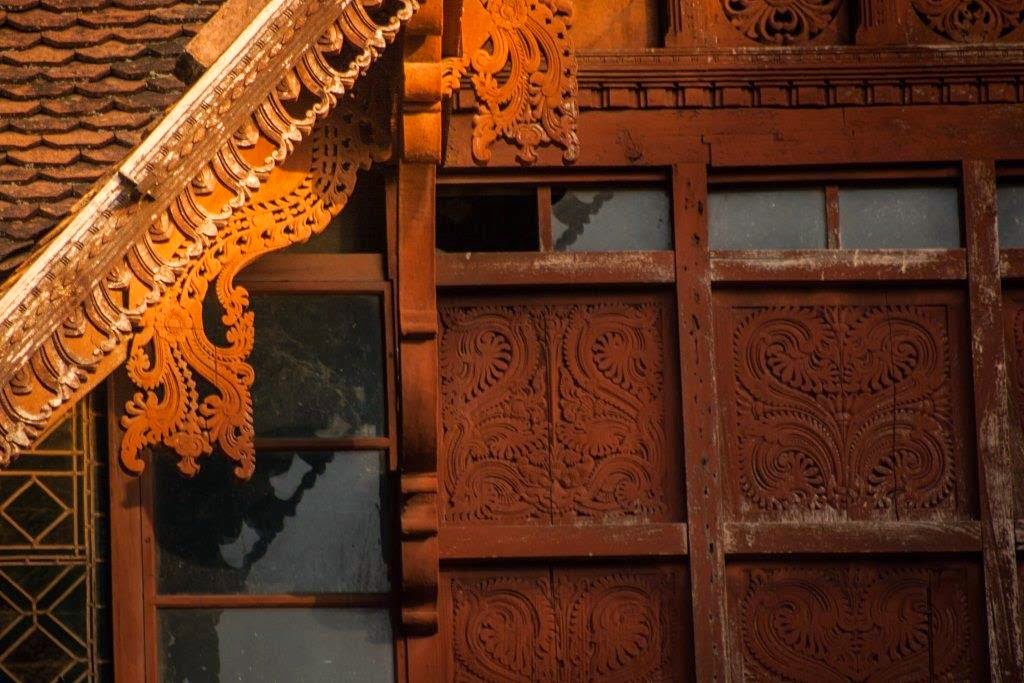 |
| Napier Museum, one of the oldest museums in India |
Once a visitor told the curator of the Museum: "I suggest, you remove all the artifacts from this building. Because the building itself is a fine object d'art and should be viewed singularly without any distractions."
I tend to agree with the visitor.
The Napier Museum in Trivandrum, Kerala in South India, is a sight to behold. It is colourful, contains engravings that makes you wonder: "How many centuries did he/she take to do that? And how did he do it?"
It is one of the oldest museums in the country, built in 1857 by the Maharaja Uthram Thirunal.
In 1872, Lord Napier, the Governor General of Madras Presidency, sent the 19th century English architect Robert Chisholm to Trevendrum (as it was then spelt) to design the museum for the Maharaja. The construction was completed in 1880. Chisholm based his design for the Napier Museum on an attractive form of domestic art seen in the numerous palaces of the rajahs.
 |
| Ceiling that was hand-painted using vegetable dyes centuries ago |
Napier Museum, which stands in the lush Observatory gardens is a combination of British, European, Chinese and Mughal styles combined with Kerala's traditional forms of construction. You can be forgiven for expecting a mish-mash. But it is not. Some might call it garish. But again, it is not. And its walls carry humongous history.
The Museum is constructed at the highest terrace with porticoes at
 |
| Yaali or dragon is seen supporting balconies and beams throughout the museum. Made of teakwood |
The museum is filled with rare artifacts from a bygone era. But they are all easily forgotten once you look up — at the ceiling! Spectacular coffered vaulted ceiling with hand-painted panels, beams and cross-beams. Remember, they were done at a time you and I weren't even tadpoles in God's lily pond. The coffers are mesmerizing with Oriental frescoes of flowers and leaves in earthy colours in contrast to the wooden braggers of dragons supporting the painted horizontal beams and cross-beams made of teak wood. The colours on the frescoes are continually changing depending on the light of the day.
 |
| Engraved wooden corbels also known as tassels or braggers supporting the balconies |
 |
| carved gable roof |
The building has double walls with ventilators, which trap the hot air, cooling it before allowing it to flow into the museum providing a cooling effect without any modern air conditioners.
As you wind your way up the narrow stairway to the top of one of the four watch towers, you are greeted with a breathtaking view of the city and an aerial view of the Museum itself.
The Napier Museum with its high arches, intricately carved balconies, hand-painted frescos and stone ornamentations stands testimony to a cultural sharing from eons ago. It is a must-see.
Some more photos:
 |
| wrought iron railing and intricately designed walls inside the museum |
 |
| colourful frescos on the ceiling that has umpteem beams and cross-beams made of teak wood |
 |
| View of one part of the museum from one of the watch towers |
 |
| Intricately designed gabled roof |
 |
| Images of gods and goddess, the deities of the royal family, could be found atop every door |
 |
| Even back then they knew stripes are chic. Colourful interiors of the museum |
 |
| Stained glass windows, carved arches, colours, frescos — all makes Napier Museum an art piece by itself. |
No comments:
Post a Comment